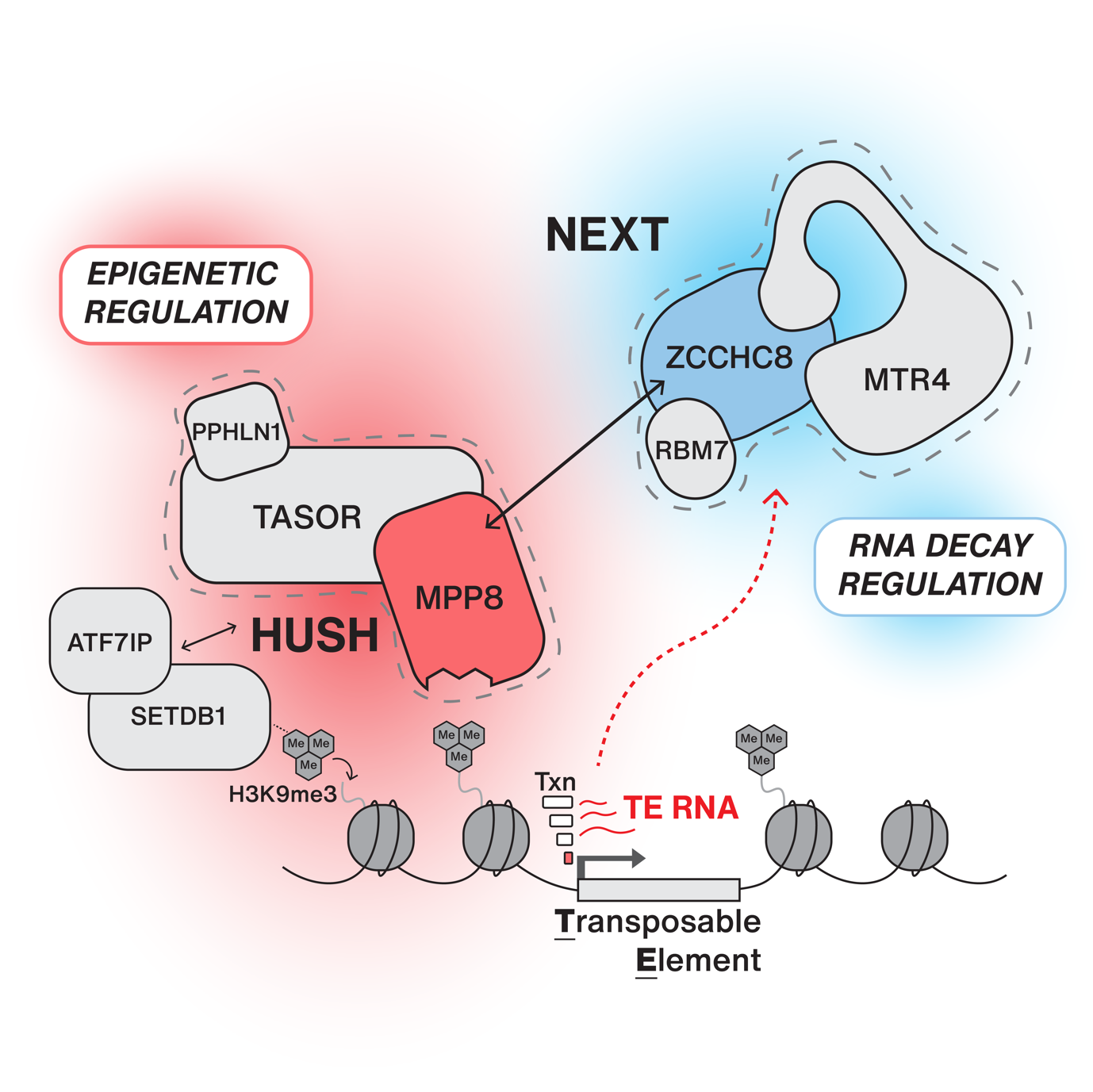Uncovering a cooperation between RNA decay and chromatin regulating complexes that keep transposable element RNAs under control
Mammalian genomes have been colonised by transposable elements (TEs), so called ‘genetic parasites’, which occupy ~ 50% of genomic DNA and harbour the potential to propagate, resulting in genetic instability. These elements are therefore subjected to tight cellular control. Whilst our understanding of TE regulation has been dominated by transcriptional and epigenetic models, the role of post-transcriptional RNA decay regulation has until now been unexplored.

Now, a Danish team has identified a connection between the mouse orthologous “nuclear exosome targeting” (NEXT) and the “human silencing hub” (HUSH) complexes, involved in nuclear RNA decay and epigenetic silencing of TEs respectively. The researchers show that NEXT globally supresses TE RNA levels in mouse embryonic stem (ES) cells, and that this is aided by a recruitment to TE loci via the HUSH complex. This reveals an unprecedented collaborative mechanism of transcriptional and post-transcriptional control to limit the genotoxic activity of TE RNAs.
Previously, the Torben Heick Jensen laboratory identified and characterised the NEXT complex that target non-adenylated (pA-) RNAs to the nuclear exosome complex for decay. Upon depletion of NEXT, cells stabilise and accumulate such RNAs, but a putative role of NEXT in the regulation of TE RNAs had remained unexplored.
To investigate this, the NEXT component ZCCHC8 was knocked out (KO) in ES cells using CRISPR/Cas9 followed by high-throughput RNA sequencing and a focussed analysis of TE RNAs. Interestingly, this showed that TE RNAs were stabilised in NEXT KO conditions.
Upon further examination, it was shown that NEXT physically interact with HUSH via ZCCHC8 and that this connection provides a method of recruitment to target NEXT to DNA to degrade pA- TE RNAs whilst HUSH functions to regulate pA+ TE RNAs. This combinatorial mechanism ensures that TEs remain restricted by the collaborative functions of NEXT and HUSH.
These findings are a result of a collaborative project between the laboratories of Torben Heick Jensen at the Department of Molecular Biology and Genetics, Aarhus University, Kristian Helin at the Center for Epigenetics, Memorial Sloan Kettering Cancer Center and Albin Sandelin at the Biotech Relearch and Innovation Centre (BRIC), Copenhagen University. The studies were spearheaded by postdoc Will Garland from Aarhus University.
This study was published in the internationally recognised journal Molecular Cell.
Chromatin modifier HUSH co-operates with RNA decay factor NEXT to restrict transposable element expression. William Garland, Iris Müller, Mengjun Wu, Manfred Schmid, Katsutoshi Imamura, Leonor Rib, Albin Sandelin, Kristian Helin and Torben Heick Jensen. Molecular Cell (2022) doi:10.1016/j.molcel.2022.03.004.
For further information, please contact
Assistant Professor Will Garland - garland@mbg.au.dk
Professor Torben Heick Jensen - thj@mbg.au.dk
Department of Molecular Biology and Genetics, Aarhus University, Denmark
Additional information
We strive to ensure that all our articles live up to the Danish universities' principles for good research communication (scroll down to find the English version on the web-site). Because of this the article will be supplemented with the following information:
Type of study: Experiment
External collaborators:
Kristian Helin at the Center for Epigenetics, Memorial Sloan Kettering Cancer Center and Albin Sandelin at the Biotech Relearch and Innovation Centre (BRIC), Copenhagen University.
External funding:
This work was supported by funding from: Work in the T.H.J. laboratory was supported by the Danish National Research Council, the Lundbeck Foundation, and the Novo Nordisk Foundation (NNF). Work in the K.H. laboratory was supported by a center grant to the NNF Centre for Stem Cell Biology (NNF17CC0027852), and through the Memorial Sloan Kettering Cancer Center Support Grant (NIH P30 CA008748). Work in the A.S. laboratory was supported by grants from the NNF and the Lundbeck Foundation.
Conflict of interest: Declaration of interests K.H. is a co-founder of Dania Therapeutics, consultant for Inthera Bioscience AG, and scientific advisor for MetaboMed Inc. and Hannibal Innovation.
Link to the scientific article:
Chromatin modifier HUSH co-operates with RNA decay factor NEXT to restrict transposable element expression. William Garland, Iris Müller, Mengjun Wu, Manfred Schmid, Katsutoshi Imamura, Leonor Rib, Albin Sandelin, Kristian Helin and Torben Heick Jensen. Molecular Cell (2022) doi:10.1016/j.molcel.2022.03.004.
Contact information:
Assistant Professor Will Garland - garland@mbg.au.dk
Professor Torben Heick Jensen - thj@mbg.au.dk
Department of Molecular Biology and Genetics, Aarhus University, Denmark
